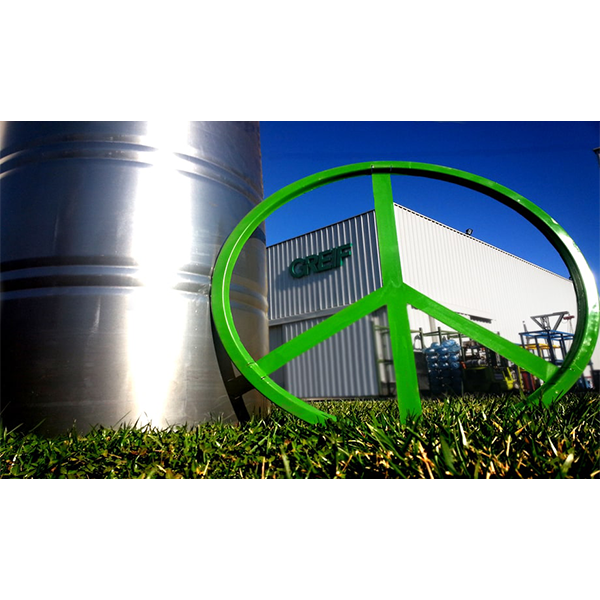Highlights
- Risk management allows us to proactively mitigate adverse impacts on our business, customers and the environment.
- Our Board of Directors takes an active role in the oversight of significant risk, while our Executive Leadership Team is responsible for the day-to-day management of the enterprise risks identified by our Risk Leader Committee in our Enterprise Risk Management process.
- Sustainability and climate-related risks and opportunities are integrated directly into our overall Enterprise Risk Management process and considered alongside all information provided by assurance providers across the organization. Greif has performed a Task Force on Climate-related Financial Disclosures (TCFD) gap assessment, climate risk workshop and robust ESG materiality assessment to understand and respond to climate-related and other ESG-related risks and opportunities.
- Annually, we conduct enterprise-wide crisis response tabletop exercises to ensure appropriate procedures are in place to respond to unforeseen emergencies. In 2022, we conducted a tabletop exercise preparing our Crisis Response Team for cybersecurity topics.
Why Risk Management Matters
Risk management allows us to proactively mitigate adverse impacts on Greif, our customers and the environment. Robust risk management processes increase stability across our value chain, increase financial predictability and mitigate legal liability. By effectively managing our risks and building a resilient organization, we are ensuring the quality of our products, bolstering the safety of our colleagues and customers and maintaining commitments to our stakeholders and the environment.
Governance
Our formal Enterprise Risk Management (ERM) process assesses organization-wide risk, encompassing all business units globally. As we restructure ERM within Risk Management, we will focus on spending additional time on this process, incorporating more early engagement from the Executive Leadership Team (ELT). Risk management oversight is provided by Executive Leadership, Sustainability Steering Committee (SSC), Internal Audit and Legal/Compliance groups. We also assess stakeholder feedback from customers and investors.
We incorporate sustainability updates and risk statements into our 10-K and proxy statements and include ESG-related issues and risks in Leadership Council meetings. ESG remains a strategic priority for the Leadership Council, focusing on embedding our sustainability priorities – climate, waste, circularity, environmental compliance and diversity, equity and inclusion – into our culture, colleagues’ daily behaviors and risk management processes. These priorities were exemplified by introducing our Build to Last strategy in 2022. We regularly report sustainability key performance indicators (KPIs) to the ELT, Vice Presidents, and business unit and regional leaders and provide quarterly sustainability updates to the ELT. We communicate regular sustainability updates to the organization, including critical risk updates, via regular town hall meetings, webinars, virtual plant tours, weekly internal news updates and quarterly podcasts. We plan to continue these communication strategies in 2023.
Launched in 2019, Greif’s Crisis Management Program is vital to our ability to respond to potential crises effectively. Greif’s alert system is capable of notifying and updating our colleagues via text message, phone call, email and smartphone app during emergencies and significant situations that pose a danger or disrupt work operations. The system is also used to assemble Greif’s Crisis Response Team, a team of executive leaders responsible for coordinating communications and response to crises and executing Greif’s Crisis Communications Playbook. In 2022, our Crisis Response team facilitated an enterprise-wide crisis response tabletop exercise to ensure appropriate procedures are in place to respond to unforeseen emergencies.

Maintaining Our Commitments Through Natural Disasters
In 2021, our Texas facilities were impacted by severe winter storms. We enacted our Crisis Management Protocols and shut down our facilities to ensure the health and safety of our colleagues. Our facilities were closed between four and ten days to allow enough time to restore power and repair damages. Since the winter storms also impacted our local customers, our customer supply was not affected. We maintained colleague safety during the storms and prioritized a safe work environment for our colleagues before they returned to our facilities.
To identify emerging risks that may impact our business, we monitor and assess various sources, including industry reports (i.e., World Business Council for Sustainable Development (WBCSD) ESG Enterprise Risk Management Framework), trade associations, ESG ratings and rankings, energy pricing and evolving government regulations and programs. We also hold formal relationships with ESG-specific associations and NGOs, including WBCSD and the United Nations Global Compact (UNGC), to identify emerging risks that may impact our business. Information from these groups, including long-term emerging risks, is provided to Greif’s Risk Leader Committee (RLC). The RLC comprises members of Greif’s ELT, Business Unit and Strategic Business Unit Leadership Teams, the Vice President of Sustainability and department leaders, including Legal, IT and Human Resources. Led by Greif’s chief audit executive, the RLC identifies, ranks, reviews and prioritizes risks in conjunction with Greif’s Audit Committee to determine the most critical risks based on potential impact and likelihood. Each risk is evaluated for potential opportunities and reported quarterly to the Audit Committee of Greif’s Board of Directors for approval. The RLC evaluates risks to develop plans for risk mitigation and opportunity capture. In 2022, the RLC identified long-lasting plastics as a risk.
Recognizing the importance of emerging climate-related risks to Greif’s businesses, we held internal workshops to develop our colleagues’ understanding and awareness of climate-related risks and opportunities in 2021. Colleagues from various regions and departments attended the workshops and collaborated in cross-functional teams composed of individuals with diverse expertise to provide unique perspectives. As a result of these workshops, carbon pricing mechanisms, natural catastrophes, obtaining renewable raw materials, shifting customer preferences and demand for sustainable products were identified as the top five risks. The results were presented to our CEO and CFO in 2022. Please visit the Climate Strategy Section of our report to learn more about our climate workshops.
Climate-related risks and opportunities are integrated directly into our overall ERM process and considered alongside all information provided by assurance providers across the organization. Greif has historically identified extreme weather events, raw material price and supply volatility and rising sea levels as our most significant climate risks through this process. In 2022, we conducted a scenario risk-based assessment and transition risk analysis to identify additional climate-related risks and further our understanding of these risks. More information about these additional risks can be found in the Climate Strategy section. We are currently analyzing physical risks and plan to share our findings in 2023. For more information regarding our climate-related risks and opportunities, please see section C2 of our 2022 CDP response.

Employing Appropriate Insurance Strategies
Over the last few years, Greif has faced new and additional challenges because of wildfires. To mitigate risks associated with the disruptive nature of these events, we are employing new insurance strategies. We are keeping these risks at the forefront of our risk management approach and considering how the impacts of climate change may further contribute to these risks.
Goals, Progress & Performance
We reassess our risk prioritization rankings as part of our quarterly meeting with the Audit Committee of Greif’s Board of Directors. Greif’s risk ranking consolidates our organization’s 15 most significant top-down risks. This accounts for the likelihood of occurrence within the next 12 months and the potential impact over the duration of the event. The ranking also considers factors such as increases or decreases in the likelihood of occurrences and speed from the onset of the risk to the impact. Our consistent monitoring allows Greif to address risk promptly and ensure company-wide stability adequately. Through our ERM process, we evaluate our ongoing progress to mitigate risk and our business’s risk factors.




